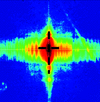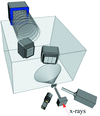issue contents
May 2020 issue

Cover illustration: Small-angle scattering tensor tomography allows for tomographic reconstruction of the orientation of nanostructure, such as mineralized collagen in bone presented here (see Guizar-Sicairos, Georgiadis and Liebi, pages 779-787). The image shows the comparison with micro-computed tomography and the validation obtained by measuring thin sections of the same sample.
facility information
editorial
Free 

A virtual special issue of Journal of Synchrotron Radiation advances in the field of X-ray free-electron lasers.
research papers
The development of a wide-beam ultra-precision d-spacing mapping measurement system that is more than ten times faster than the previous pencil-beam method is presented.
Open  access
access
 access
accessA simple and reliable way of characterizing double-sided hard X-ray Fresnel zone plates is presented. The measurements are performed in an X-ray tube-based setup where a near-monochromatic spectrum is isolated by differential measurements with a Cu and an Ni filter.
Open  access
access
 access
accessThe implementation of saw-tooth refractive lenses at the APS 1-ID high-energy X-ray beamline is presented.
Open  access
access
 access
accessThe first experimental results from a new type of transmissive synchrotron X-ray diagnostic instrument are presented. A chemical-vapour-deposition diamond plate with graphitic electrodes and a modulation lock-in signal acquisition technique are used to image the X-ray beam.
Open  access
access
 access
accessThe ePix10ka2M is a new large area detector specifically developed for X-ray free-electron laser applications. Here the detector parameters and performance are presented, as well as the detector nonlinearity as characterized by diffuse scattering measurements at the Linac Coherent Light Source.
An in situ high-resolution powder diffraction measurement system synchronized with controlling gas and vapour pressures is presented. This system enables one to perform both automatic in situ and millisecond time-resolved measurements under gas pressures.
In this study, a photoluminescence lithium fluoride (LiF) detector demonstrates its capabilities in X-ray imaging at extreme absorbed doses with an ultimate dynamic range of ∼107 and sub-micrometre spatial resolution, all from the perspective of experiments at synchrotron sources of the next generation. Response functions of the LiF detector are provided at the 500 eV photon-energy water-window band.
Open  access
access
 access
accessThe simulation of a signal and signal-to-noice ratio for time-resolved X-ray solution scattering data is presented.
A methodology to resolve the full strain tensor under commonly encountered loading modes in experiments is developed on the basis of simulations. This method can be implemented with simultaneous X-ray diffraction and imaging techniques.
Open  access
access
 access
accessA new method using a high-sensitivity X-ray camera for a large-range diffraction pattern is presented; it confirms the effectiveness of over 35 years of conservation treatment for brass artefacts from the Mary Rose.
The development of a scanning soft X-ray spectromicroscope is described.
Zeeman quantum beats of helium Rydberg states were measured with synchrotron radiation. It is proposed that the polarization characteristic of extreme ultraviolet light can be simply evaluated by the measurement of the Zeeman quantum beats.
Application of time-resolved fluorescence-detection quick X-ray absorption spectroscopy using a partially depleted passivated implanted planar silicon detector at the SuperXAS beamline.
Open  access
access
 access
accessThis work demonstrates how the combination of resonant and non-resonant X-ray emission spectroscopies supplemented with theoretical modelling allows for quantitative analysis of electronic states around Fermi, band gap energies and strength of crystal field splitting in 5d transition metal and metal-oxide materials.
Open  access
access
 access
accessThe optical design of a soft X-ray spectrometer that utilizes Wolter mirrors to enable imaging-mode spectroscopy with a beam-size independent spatial resolution in, for example, tandem catalysts in reaction is presented. When such a spectrometer is used in pump–probe experiments to study the transient electron dynamics, the imaging capability of the Wolter mirrors can offer femtosecond time delay between the pump and probe beams with non-collinear wavefronts.
A high-efficiency transmission-mode diamond X-ray scintillator is demonstrated for detection (imaging) of synchrotron beam profiles.
Nano-resolution spectro-tomography has been broadly applied to material studies. The polarization configuration of the synchrotron X-rays could affect the X-ray absorption near-edge structure fingerprint but is not considered in the conventional approach. The current study tackles this issue and proposes a solution for the case study of LiCoO2 battery cathode particles.
To complement the limitation of whole-mount transmission electron microscopy (TEM) for assessing dense granule deficiency, scanning transmission X-ray microscopy (STXM) was used to identify calcium-rich dense granules in human platelets. Based on STXM images of human platelets, their calcium maps were extracted to identify dense granules correctly and distinguish them from other granules such as α-granules.
Open  access
access
 access
accessCoherent diffraction imaging in the forward-scattering geometry reveals AuNi nano alloy particles in a metastable mixed phase. The AuNi nanoparticles irradiated by nanosecond laser pulses exhibit the mixed phase overcoming the miscibility gap.
Open  access
access
 access
accessA technical description of an instrument that allows 3D nano-imaging via ptychographic X-ray laminography is presented.
We examined the suppression of Compton scattering background in XFCT using the linearly polarized X-rays and the implementation feasibility of linearly polarized XFCT based on this type of light source, concerning the influence of phantom attenuation and the sampling strategy, its advantage over K-edge subtraction computed tomography, the imaging time, and the potential pulse pile-up effect by Monte Carlo simulations.
A compact high-temperature furnace optimized for in situ experiments with a transmission X-ray microscope is designed and fabricated. The furnace has high-temperature stability and minimal heat footprint to the ambient environment which are critical to high-quality experiments.
The three-dimensional structure of whole anammox bacteria based on synchrotron soft X-ray imaging is presented.
The optimum geometry for the phase-contrast computed tomography examination of the breast using synchrotron radiation is investigated in terms of dose distribution in the breast, at a fixed value of mean glandular dose.
Open  access
access
 access
accessCryo soft X-ray tomography and deep-ultraviolet transmittance imaging reveal partitioning of neutral lipids in a lipid droplet core. Furthermore, deep-ultraviolet transmittance and tryptophan/tyrosine auto-fluorescence multimodal imaging on living cells were combined to obtain complementary information on organelle chemical contents.
Open  access
access
 access
accessSmall-angle scattering tensor tomography allows for tomographic reconstruction of the 3D reciprocal space from voxels within a bulk volume. In this study, the nanostructure orientation and the scattering curve along different 3D directions are validated with data obtained from thin sections of the same sample.
Open  access
access
 access
accessSuper-resolution multi-contrast X-ray imaging performed using a Shack–Hartmann sensor for hard X-rays is presented.
short communications
Open  access
access
 access
accessA rather modest upgrade of the GeV-level linear accelerator of modern X-ray free-electron lasers with purpose-built THz undulators allows generating intense, tunable and narrow-bandwidth THz pulses alongside the X-ray pulses. The enabling technological breakthroughs in accelerator physics are discussed and the arising new research possibilities are presented.
The horizontal beam property in the phase space of undulator radiation was derived using a tandem-double-slit optical system. The net effective beam emittance was extracted by deconvoluting the Fraunhofer diffraction produced by the upstream slit in the phase space.
beamlines
Open  access
access
 access
accessInstrumentation and data processing for solution scattering at the LiX beamline are presented.
An in-vacuum tender X-ray emission spectrometer with an innovative mechanics allowing displacement of 11 cylindrical Johansson crystal analyzers in a non-dispersive Rowland circle geometry is presented.
Open  access
access
 access
accessThe design and capabilities of the momentum-resolved high-energy-resolution inelastic X-ray spectrometer (HERIX) at beamline 30-ID of the Advanced Photon Source are reported.
Open  access
access
 access
accessA new beamline, XTIP, has been constructed at the Advanced Photon Source to deliver monochromatic soft X-rays of between 400 and 1900 eV for the emerging synchrotron X-ray scanning tunneling microscopy technique.
Open  access
access
 access
accessID30A-3, a highly intense mini-beam facility for macromolecular crystallography at the ESRF, is described..
computer programs
Open  access
access
 access
accessThis article describes scientific software made publicly available for phase retrieval in X-ray propagation imaging. The package is called HoloTomoToolbox and comprises a set of algorithms for phase retrieval in the direct-contrast regime, as well as in the holographic regime, which is used for high-resolution cone-beam synchrotron recordings. Further to this, a set of routines is included to facilitate the conversion of the 2D phase projections in a 3D tomogram.
laboratory notes
The TELL sample changer has been developed at the Paul Scherrer Institute with a focus on speed, storage capacity and reliability, to serve the three macromolecular crystallography beamlines of the Swiss Light Source, as well as the SwissMX instrument at SwissFEL.


 journal menu
journal menu





























































